Pilot Briefing: The welcome mat is out
Top flight school puts emphasis on community
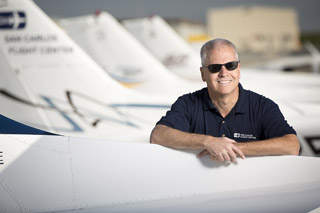 San Carlos Flight Center,which snagged the Best Flight School title in the 2013 Flight Training Excellence Awards, puts out the welcome mat in innovative ways that include an emphasis on customer service, an active events calendar, and a marketing message: “Safety—Community—Adventure.” Even the smallest details, such as an outsized drink cooler, free snacks, and photos of grinning solo students, emphasize that this is a welcoming place.
San Carlos Flight Center,which snagged the Best Flight School title in the 2013 Flight Training Excellence Awards, puts out the welcome mat in innovative ways that include an emphasis on customer service, an active events calendar, and a marketing message: “Safety—Community—Adventure.” Even the smallest details, such as an outsized drink cooler, free snacks, and photos of grinning solo students, emphasize that this is a welcoming place.
“If somebody comes by the office, it should be like stopping by your buddy’s house,” says Dan Dyer, owner and chief flight instructor. He founded SCFC at California’s San Carlos Airport in 2012, starting with one airplane, one staff flight instructor, and a half-dozen clients. Twenty months later, SCFC has 14 aircraft; three simulators; three staff instructors and another 23 independent CFIs on call; four line employees; and a receptionist. The six or so clients mushroomed to about 175.
Some things haven’t changed—namely, a focus on community. SCFC’s schedule is bursting with events—safety seminars, fly-outs, support groups, and more. Dyer and his staff invite all to become involved in SCFC’s many programs in whatever capacity they choose.
SCFC flight instructor Lisa Dyball points to “the community of flying [that] is one of the core values that Dan has brought into aviation. Other flight schools might just be rental centers or have some kind of social events here and there, but Dan tries to make aviation an opportunity for other people to build on their skills and explore the world.”
Email [email protected]
EXTRA: Conor Dancy named best flight instructor
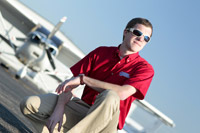 Conor Dancy, a 23-year-old flight instructor from Leesburg, Virginia, was named the best flight instructor in the 2013 Flight Training Excellence Awards. The chief instructor for Aviation Adventures, at Leesburg Executive Airport, scored highest among the 950 other instructors from across the country who were nominated by their students. The instructors were rated on 31 criteria ranging from professionalism to personality, and safety issues to financial concerns. The Flight Training Excellence Poll received 3,375 respondents. AOPA created these awards as a result of its 2010 Flight Training Experience research.
Conor Dancy, a 23-year-old flight instructor from Leesburg, Virginia, was named the best flight instructor in the 2013 Flight Training Excellence Awards. The chief instructor for Aviation Adventures, at Leesburg Executive Airport, scored highest among the 950 other instructors from across the country who were nominated by their students. The instructors were rated on 31 criteria ranging from professionalism to personality, and safety issues to financial concerns. The Flight Training Excellence Poll received 3,375 respondents. AOPA created these awards as a result of its 2010 Flight Training Experience research.
>>Learn more about San Carlos Flight Center in this video.
‘DoubleEnder’ Cub could reach kit market
By Alton K. Marsh
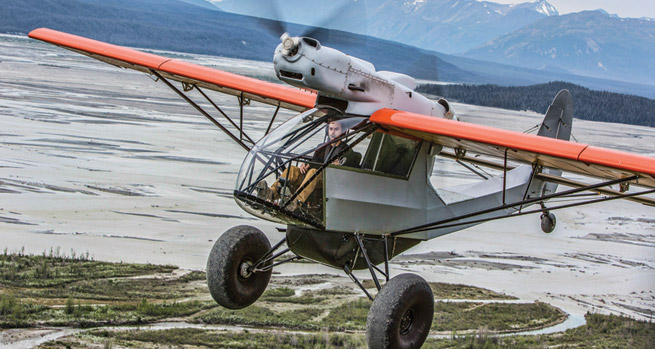
During wildlife patrols flying a Piper Cub in Kenya, Alec Wild had plenty of time to dream of the ultimate Cub for his missions, and came up with the DoubleEnder. The name comes from the two turbocharged Rotax engines that sit atop a proof-of-concept model—one facing forward and the other to the rear. It has the same wings and tail surfaces as a Cub, located in about the same positions. Landing gear and wing struts are also off a Cub. There, the similarities end. The entire front cockpit is a rugged crash cage with windows above, below, forward, and on the sides. The idea came from the Vulcanair (formerly Partenavia) P68 Observer. The wings have slats on the leading edge, like those on an airliner, that allow approach speeds of 30 mph. Flight in the 20s is possible. Speeds like that require the nose to be high in the air, but because the nose is made of windows, it doesn’t block the pilot’s vision. It can cruise at 97 mph.
The one flying now is just a proof of concept design. A more refined model will offer side-by-side seating and perhaps an empty weight less than the 1,400 pounds of the prototype. Weight isn’t the issue—it’s all about safety. There have been many times that Wild has altered his route above Africa to avoid hazardous terrain and water in case of engine failure. What if you could just increase power on the second engine and continue on your way? Visibility is the key to landing in rugged terrain, so what if the entire front of the aircraft was one big window? You’ll want to land as slowly as possible in places that don’t remotely resemble an airport, so why not slats for low-speed maneuvering?
Doug Keller did the structural engineering and blueprints that were converted to an airplane by Eric Lewis. Lewis once worked on the Sherpa bushplane, while Keller has past experience with the Aviat Aircraft Husky and CubCrafters Carbon Cub. The idea went on paper in 2007 and first flew in 2010.
Email [email protected]
DoubleEnder Specs
- Two Rotax 914 turbocharged engines
- Two 25-gallon fuel tanks
- Wayne Mackey slats and selectable drooping ailerons
- CubCrafters 2,300-pound wing reinforcements
- Warp Drive 72-inch, three-blade propellers
On the web: See more about the airplane at bushplanedesign.com, or you can watch it dive off a cliff (and survive) at http://tinyurl.com/k32sxjs.
New bill would expand driver’s license medical
After nearly two years of FAA inaction on the AOPA/EAA third class medical petition, Congress has taken matters into its own hands, offering up legislation that would expand the number of pilots who could fly without going through the expensive and time-consuming third class medical certification process. Reps. Todd Rokita (R-Ind.), a member of the House General Aviation Caucus, and GA Caucus Co-Chair Sam Graves (R-Mo.) introduced the General Aviation Pilot Protection Act. The legislation would dramatically expand the parameters for flying under the driver’s license medical standard.
“We have waited far too long for the FAA to expand the third class medical exemption to more pilots and more aircraft,” said AOPA President Mark Baker. “Congressmen Rokita and Graves stepped forward to take decisive action in the best interests of general aviation when the FAA refused to act.”
The General Aviation Pilot Protection Act would allow pilots to use the driver’s license medical standard for noncommercial VFR flights in aircraft weighing up to 6,000 pounds with no more than six seats. That includes virtually all single-engine airplanes with six or fewer seats, including Beech Bonanzas, as well as many light twins. By way of comparison, most large SUVs on the roads today weigh more than 6,000 pounds and can carry six to seven passengers, making them larger than the aircraft that could be operated under this new bill. Pilots would be allowed to carry up to five passengers, fly at altitudes below 14,000 feet msl, and fly no faster than 250 knots. The act also would require the FAA to report on the safety consequences of the new rule after five years.
The legislative action comes after the FAA repeatedly declined to rule on a March 2012 petition filed by AOPA and EAA. That petition asked the FAA to expand the driver’s license medical standard already used by sport pilots. Under the petition, pilots would be able to operate noncommercial VFR flights in single-engine aircraft with 180 horsepower or less, four or fewer seats, fixed gear, and a maximum of one passenger. To participate, pilots would need a valid driver’s license and would be required to take recurrent safety training to help them accurately assess their fitness to fly.
Wings in waiting
New four-seaters on their way
By Alton K. Marsh
New four-seater aircraft are on their way from companies in Europe that are better known for their two-seat Light Sport aircraft. They include the Pipistrel Panthera, Flight Design C4, and Tecnam P2010.
The Pipistrel Panthera will cost between $500,000 and $600,000, depending on whether you build one yourself in the Experimental category or let the factory do it. Experimental models will begin deliveries in 2014, while fully certified ones will be available in 2017. The company promises 200 knots true airspeed using a 210-horsepower Lycoming IO-390. They even promise full-electric and hybrid engine models, but have decided against using a diesel engine.
The Flight Design C4 promises a maximum cruise speed of 160 knots true airspeed using a 180-horsepower Continental IO-360-AF (alternative fuels) engine or an unnamed-as-yet diesel engine. Fuel consumption is promised to be no more than 10 gallons per hour. The price will be $250,000 with certification in Europe at the end of 2014. Certification in the United States will follow shortly after that, in 2015. Flight testing of a proof-of-concept model is to take place in Spain followed by construction of prototypes that conform to production specifications.
The $275,000 Tecnam P2010 (named for the year it was designed) isn’t waiting for a change in United States certification rules, and could be certified in Europe as soon as April, with FAA certification to follow under a reciprocal agreement. It will use a 180-horsepower Lycoming IO-360 engine and have a cruise speed of 133 knots true airspeed. Its full-fuel payload is 630 pounds, with a maximum takeoff weight of 2,557 pounds. It is planned to be a VFR aircraft.
Email [email protected]
First Look
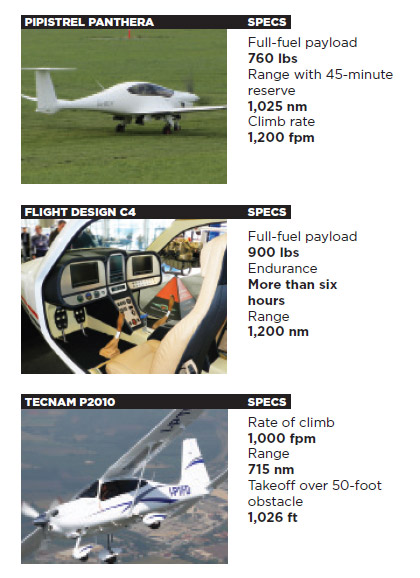
Shell offers hope for a new unleaded fuel
Details are still elusive, but Shell Aviation has tested for 10 years a leadless fuel that can substitute for aviation fuel using “a couple of additives,” says Shell researcher Michael Sargeant. Regulators in the United States are shooting for an answer by 2018, so it is encouraging to hear positive news from a company with the deep pockets (needed for certification of the fuel) such as Shell (see “Waypoints: Toward an Unleaded Fuel,” page 16).
The lead-free formulation has a motor octane number (MON) higher than 100, a critical factor in formulating a fleetwide fuel that could power high-compression engines. (Octane prevents premature ignition known as detonation, and is measured by more than one scale.) Shell’s new lead-free formula has passed preliminary tests in Lycoming engines on the ground, and a Piper Saratoga recently flew for about an hour on the fuel, according to Shell.
Shell must keep its formula secret for now if it wants to be competitive, so exact details such as weight and cost have not been announced. Weight will be similar to 100LL and cost “comparable,” Sargeant said. There are years of approvals ahead. Renewable fuel fans will be disappointed that it is not a biofuel, but those with angst about a potential shortage of 100LL in the future have a new source of hope.
—AKM
Super Legend becomes 122nd LSA
With the approval of the Super Legend Cub late last year, there are now 122 models of Light Sport aircraft for you to buy. The aircraft, powered by a 115-horsepower Lycoming engine, is actually the 132nd light sport model to win approval, but 10 models are out of production. More are on the way, including seaplanes.
American Legend officials celebrate certification (see “Harley in the Sky,” January 2014 AOPA Pilot).
Ice protection in a can?
Testing hydrophobics
By Dave Hirschman
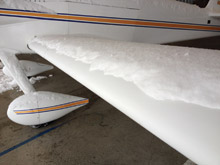 Ice is a danger that all pilots must carefully consider this time of year, and avoid as best we can. And we may get some surprising help from some new nanotechnology compounds designed to repel water and prevent ice from forming on treated surfaces. These “hydrophobic” materials can be used to protect everything from industrial equipment to boots from getting soaked or saturated. But what about aircraft wings?
Ice is a danger that all pilots must carefully consider this time of year, and avoid as best we can. And we may get some surprising help from some new nanotechnology compounds designed to repel water and prevent ice from forming on treated surfaces. These “hydrophobic” materials can be used to protect everything from industrial equipment to boots from getting soaked or saturated. But what about aircraft wings?
I recently purchased a product called Never Wet ($18 at Home Depot) and applied it to the leading edges of the wings and control surfaces of my Van’s Aircraft RV–4. Never Wet comes in two spray cans. Spray on a base coat, then wait 30 minutes and spray on the top coat. It dries in a mostly transparent mat finish that’s noticeably rough to the touch, like fine-grit sandpaper. You’d think a product designed to repel water would be glossy, but that’s not the case. Also, since it’s not perfectly transparent, it’s not suitable for aircraft canopies.
A day after applying the compound, I searched out some stratus clouds that produced trace amounts of ice on a few portions of the airframe, but nothing conclusive. Then the Mid-Atlantic region got hit with a winter storm with rapid accumulations of snow and ice.
I pushed the airplane outside a hangar at Frederick Municipal Airport in Maryland and left it there for several hours while the frozen precipitation fell. When I returned, the airplane was covered in about three inches of snow. I had anticipated the snow might slide off the treated wing leading edges, but that wasn’t the case. The snow was uniformly distributed across the wing.
But was it stuck there? Had the heavy, wet snow adhered to the treated wing leading edges? I took a deep breath and blew against the wing, and the snow on the treated surface flew off. On the untreated portions of the wing, the snow clung heavily and remained in place. After a few minutes of huffing and puffing, the treated portions of the wing were clear and dry, and a blanket of wet snow stayed draped over the rest of the airframe.
Obviously, this isn’t a scientific test. There’s a great deal more that has to be done to determine whether hydophobic compounds can inhibit airframe ice accumulation and enhance flight safety. But at first blush, it looks very promising. I use Rainex on my car windshield— and I won’t hesitate to use Never Wet or other hydrophobic compounds on my aircraft. (The FAA hasn’t attempted to regulate the kinds of coatings we put on aircraft surfaces.)
These hydrophobic compounds aren’t meant to replace robust deice and anti-ice systems meant for flight in known-icing conditions. But the nanotechnology compounds could be helpful in allowing pilots to escape inadvertent icing encounters, and that would be a valuable contribution. And in the spring ,when temperatures warm up and the threat of low-level icing becomes a distant memory, hydrophobic compounds are easy to remove with mineral spirits (and lots of muscle).
Email [email protected]
Look good while being prepared
Sunglasses, nav/com, satellite tracker
DeLorme inReach SE
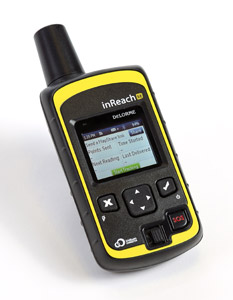 If you’d like family and friends to be able to track your progress on a flight, or you’d like to see your flight path over a map after you land—or both—consider the DeLorme inReach SE. This compact unit (2.4 by 5.9 by 1 inches, including integral antenna) weighs 6.7 ounces, including its internal lithium polymer battery.
If you’d like family and friends to be able to track your progress on a flight, or you’d like to see your flight path over a map after you land—or both—consider the DeLorme inReach SE. This compact unit (2.4 by 5.9 by 1 inches, including integral antenna) weighs 6.7 ounces, including its internal lithium polymer battery.
Not only does the inReach SE track your flight on a real-time basis, communicating your position via the Iridium satellite network, it also allows you to send and receive 160-character text messages. This, combined with a simple SOS function that connects you to a manned search and rescue monitoring center, made it perfect for review during a recent flight around the world (see “Around the World in 25 Days,” December 2014 AOPA Pilot).
Setup is simple and straightforward; a user helpdesk is available if needed. The satellite communicator can, with the press of a couple of buttons, send prewritten text messages that you have stored in the unit. To fully unlock its communications potential, use Bluetooth to pair the inReach SE with DeLorme’s Earthmate app, available for most mobile devices. Using an iPad, I was able to download detailed map data and, through the Explore web portal, my email contact lists; in flight I could then track our progress, as well as identify many terrain features that did not appear in our Garmins’ Jeppesen databases or on printed aeronautical charts. I also could send text messages to any of my email contacts.
The biggest surprise came when I began receiving emails from people I didn’t know who were following the flight. If you enable it during setup, anyone can message you by clicking Users List and then the Message icon on the MapShare tracking map; I never mentioned this capability on my daily blog but three dozen people either knew about the capability from their own DeLorme experience or just discovered it. Their surprise came when they received an email response, from Flight Level 250 over the North Atlantic or Indonesia. (Don’t want to be followed? You can protect your MapShare with a password, and share it only with those you want to have access.)
I was a bit apprehensive about performance of the built-in battery, estimated to provide 100 hours of battery life when tracking in 10-minute increments and with an unobstructed view to satellites—in many ways, replacing AA or AAA batteries would have been easier. My demo unit started a little slowly, going through 30 to 35 percent of its charge on each of the trip’s early days. Later, however, I was using the inReach SE 40 hours or more between charges, with the battery seldom dropping below 50 percent.
The DeLorme MapShare tracking map of the flight can be seen online (https://share.delorme.com/MikeCollins#). I did not find it necessary to evaluate the SOS function, and I trust that you won’t, either. —Mike Collins
Price: $299.95 plus usage-based subscription service, $9.95 to $64.95 per month
Contact: www.inreachdelorme.com/ or pilot supply
Serengeti sunglasses
Serengeti has always produced some of the top eyewear for pilots, and two of the company’s new designs live up to that brand standard. Sortie hints strongly at the iconic military aviator style popularized by Randolph, while Sassari is a more universal style that’s at home in the cockpit. Sortie has the classic aviator square shape with broad, flat, flexible temples that are exceedingly comfortable under a headset. The titanium frame stands out against the gray lenses that have been optimized for bright light conditions. Sassari looks good even to nonpilots, and comes in a variety of lens tints. The temples are more traditional, but also are very comfortable. A twin-prong spring hinge ensures the flexibility to fit a variety of faces.
Prices:Sortie MSRP $269.99; Sassari MSRP $199.99
Contact: www.serengetieyewear.com
Sporty’s SP-400 Handheld Nav/Com
Sporty’s Pilot Shop’s unique SP-400 nav/com now comes with a brighter screen, pilot-adjustable contrast, adjustable backlight, and a night mode. It features standard nav/com frequency range, including a full ILS display. Despite the huge advancements in cockpit technology, the need for a reliable, well-built handheld nav/com remains. If you’re someone who relies on one for no-radio situations, the SP-400 is one of the best.
Price: $369
Contact: www.sportys.com; 800-776-7897
Distractions in high-workload situations
Honeywell looks for ‘sweet spot’
By Sarah Deener
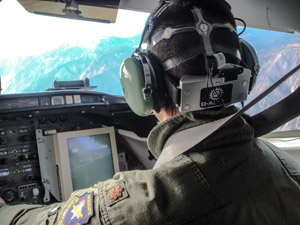 Mounting distractions in a high-workload phase of flight can test the limits of a pilot’s ability to focus and perform. But what if a system could tap into pilots’ brain waves to automate tasks when they’re overwhelmed?
Mounting distractions in a high-workload phase of flight can test the limits of a pilot’s ability to focus and perform. But what if a system could tap into pilots’ brain waves to automate tasks when they’re overwhelmed?
Honeywell Aerospace researchers have used electroencephalography (EEG) sensors to quantify brain activity and cast light on when someone is at higher risk of making mistakes. The system could inform technologies that nudge pilots and other aerospace workers from error-prone mental states into their neurological “sweet spot,” where their performance is highest.
A little stress can be a good thing. With excessive stimuli, however, people become frazzled and performance deteriorates. Recognizing that its systems’ effectiveness depends on human operators, Honeywell has developed a measurement of cognitive effort that can inform future technologies by identifying when a pilot is either overloaded or inattentive.
Santosh Mathan, principal scientist in the Honeywell Human Centered Systems Group in Advanced Technology, said EEGs give a more accurate and immediate measurement of workload than pilots’ recollections or assessments of physical responses. Using electrodes on the scalp, researchers have recorded and processed the brain’s electrical activity of pilots at a simulator to produce a single metric of cognitive effort. This metric lays the groundwork for emerging technologies to step in. The technology can aid Honeywell in testing its product designs, identifying aspects of a design that make users work harder so that developers can improve it. It could also detect lapses of attention, as when a baggage screener has been staring at a screen for long periods of time.
In flight, new systems could tackle the doldrums of cruise flight by engaging a pilot with relevant tasks when attention dips; on the high-workload end of the spectrum, future technologies could recognize a pilot reaching mental saturation and bring in automated assistance. Instead of thinking of automation as an all-or-nothing proposition, Mathan said, we could use it in proportion to what’s needed.
Commercial Honeywell systems may not tap into pilots’ brains anytime soon, but the research is a logical next step for the company, whose products already aim to minimize excess stimuli at times when workload may overwhelm a pilot. SmartView synthetic vision declutters the screen when it detects an unusual attitude to focus the crew’s attention on correcting it; a 3-D taxi system in the works removes roll and pitch instruments when the aircraft is on the ground and visually emphasizes important markers such as hold short lines while de-emphasizing potential distractions.
Email [email protected]
This month on the AOPA Jay
Formation Flying
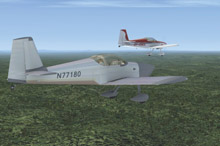 One of the perks of working with AOPA Pilot is flying in formation for photo shoots. It’s flying that’s demanding and potentially dangerous, but also a lot of fun. You can experience the basics with this scenario for the AOPA Jay. You’ll command a Van’s RV–7 flying on the wing of a second RV–7 to learn basic formation. Throughout the flight, a helpful voice from your co-pilot will help keep you in just the right spot.
One of the perks of working with AOPA Pilot is flying in formation for photo shoots. It’s flying that’s demanding and potentially dangerous, but also a lot of fun. You can experience the basics with this scenario for the AOPA Jay. You’ll command a Van’s RV–7 flying on the wing of a second RV–7 to learn basic formation. Throughout the flight, a helpful voice from your co-pilot will help keep you in just the right spot.
Don’t have your AOPA Jay yet? Find out more online.
See more about formation flying with this related content from AOPA Media
“Formation Flying in an LSA” (http://tinyurl.com/kembmgb)
“Fly like a Fighter: Cross-Controlled in
Tight Formation” (http://tinyurl.com/ngwfblu)
“Formation Fumbles” (http://tinyurl.com/pda2psd)
“Air Safety Quiz: Collision Avoidance” (http://tinyurl.com/kteazg9)
“ASF—Midairs” (http://tinyurl.com/mqbcuye)
Debonair flight log
A sweepstakes familiarization flight
By Thomas A. Horne
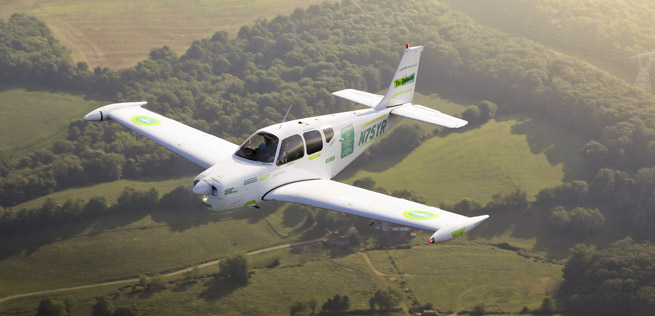 I’m often asked what it’s liketo fly the 1963 Debonair, now that its new avionics and interior are installed. I’ve put about 62 hours on it as of late November 2013, and it’s been quite an experience. The early hours were challenging with a windshield that was practically opaque with scratches when flying up-sun, uncomfortable seats, and avionics that mostly didn’t work well at all. Its one working VOR receiver would allow you to navigate—as long as you were close enough to the station that you could see it! I used my Garmin aera 560 handheld, perched atop the glareshield.
I’m often asked what it’s liketo fly the 1963 Debonair, now that its new avionics and interior are installed. I’ve put about 62 hours on it as of late November 2013, and it’s been quite an experience. The early hours were challenging with a windshield that was practically opaque with scratches when flying up-sun, uncomfortable seats, and avionics that mostly didn’t work well at all. Its one working VOR receiver would allow you to navigate—as long as you were close enough to the station that you could see it! I used my Garmin aera 560 handheld, perched atop the glareshield.
The original airplane’s 55-ampere alternator, weak battery, and leaky induction airbox caused problems on the fourth and sixth legs I flew it. On my way to AOPA Summit 2012 in Palm Springs, I made a stop at Wichita’s Colonel James Jabara Airport to get fuel and pick up Senior Photographer Mike Fizer. After takeoff the landing gear wouldn’t retract, although the system tried so hard that it popped the landing gear circuit breaker (the Debonair has an all-electric landing gear system). So it was back to Jabara for a gear cycling test (of course it worked perfectly on jacks), and topping off the battery’s charge.
On the leg from Wichita to Tucumcari it became apparent that the airplane wasn’t performing according to the numbers published in the pilot’s operating handbook. The climb out of Tucumcari (temperature: 85 degrees Fahrenheit; elevation: 4,047 feet; density altitude: about 7,800 feet) at VY yielded a 100- to 200-fpm climb rate. It should have been more like 400 fpm. Now I doubted if the airplane would get to a safe cruising altitude without exceeding the oil temperature redline. Step-climbs got us to 10,000 feet, but darkness was setting in as we approached Albuquerque, and I had a bad feeling. We were cruising 10 to 15 knots slower than book. The aircraft was obviously not very happy at all in high density altitudes. The gear hadn’t retracted back at Wichita. Would they extend when next called on? And now darkness had fallen, and I’d promised myself I wouldn’t fly the airplane at night until the panel had been upgraded.
Well, the landing at Albuquerque International Sunport was uneventful, and the no-go call for the leg to Palm Springs was easy to make. Besides, Santa Fe Aero Services was nearby. I left the airplane there for its many avionics upgrades and an annual inspection, and went on to Palm Springs on the airlines.
Of course, after getting the new panel installed at Santa Fe Aero Services it suddenly was sensory overload! I went from a sick panel to one with multiple screens and multiple navigation sources, as well as many new features that made subsequent legs that were as information-rich as could be expected. Yes, there was a learning curve when it came to flying with the Aspen Evolution displays and the Garmin GTN 750 and GTN 650 radio stack, but no such curve at all when it came to using the panel-mounted iPad Mini—complete with its own source of traffic information via the Garmin GDL 39 GPS/ADS-B-In receiver. Now there are six different moving maps in the airplane, two different sources of weather information (XM WX and FIS-B), and two different sources of traffic information (the GDL 39 on the Mini and TIS-B data). This level of equipment certainly boosts confidence—and so did the new 70-ampere alternator provided by National AirParts, the airbox that Santa Fe Aero Services repaired as part of the annual, and the reconditioned fuel control unit. The engine had new life, good compressions, and it was making book speeds. Yes, there is an issue with cylinder wear and pitting. I know, because of the Aspens and the Electronics International MVP-50P engine and systems analyzer. The MVP is a great multipurpose tool, by the way. To lean for cruise, you use the rotating knob at the unit’s lower left. Push it, then rotate to select either rich or lean of peak EGT. Push again, then rotate the knob so that the cylinders’ vertical temperature bars are highlighted. Begin leaning, and the first cylinder to reach peak displays a white bar across the top of its EGT column. Then it’s a matter of leaning until you observe the proper temperature reduction, which is displayed for each cylinder. I’ve been running 50 to 100 degrees rich of peak EGT, and at the latter setting true airspeed typically works out to be 150-153 knots at 6,000 to 8,000 feet and OATs around 10 degrees Celsius/50 degrees Fahrenheit.
Another good thing about the MVP-50P is its master warning and caution feature. Should a serious condition crop up—such as, say, low oil or fuel pressure, low fuel quantity, or an alternator failure—your attention is drawn to the red and amber lights mounted next to the GTN 750’s bezel. It’s right in your field of view, so a warning is hard to miss.
A lot of pilots have asked me about the 20-gallon-per-side tip tanks. If they’re full, is handling an issue? In cruise, no problem in my experience. I just make sure to transfer fuel equally so that there’s not too much of a fuel imbalance. Takeoffs and landings, however, can be challenging in crosswinds. With full tip tanks and a stiff, direct crosswind, full aileron deflection is an absolute must if you want to stay on the runway centerline. You can really feel the extra weight way out there on the tips, and this can make for sluggish aileron response—something I found out on a couple of turbulent takeoffs. If a wing starts to drop, you’ll need a lot of muscle, real fast, to get back to wings-level.
As for landings and takeoffs, they’re no-sweat affairs. Add full power, take a glance at the MVP-50P to make sure all’s well under the cowl, release the brakes (there are no brakes on the co-pilot side, by the way), accelerate, start pulling around 60 knots, rotate at 68 knots, and climb away at the VY of 90 knots while retracting the gear when there’s no runway available for landing. Gear retraction takes about 10 to 12 seconds, which I’m told is normal for a 12-volt Debonair or Bonanza.
In preparation for landing I usually reduce power to 15 or 16 inches of manifold pressure in order to slow to the VLO of 144 knots. When I get there I remind myself: the gear control switch is on the right side, and the flap switch is on the left side. This airplane was built well before the General Aviation Manufacturing Association (GAMA) standardization conventions were adopted industry-wide in 1976, so it has the old-school gear and flap switch locations.
With the gear down, deceleration to a comparatively low VFE of 106 knots takes a few seconds, then you can lower the flaps to half-deflection at the midfield downwind point. (There are no detents, by the way; you simply hold down the flap switch and watch the flap indicator dial for the deflection angle—or take a look out the window—then center the switch to stop flap movement). After that initial flap extension, you typically can reduce power another inch or so, which will get you 90 or so knots by the time you’re on base leg. With the runway made you can go to full flaps (a 30-degree deflection), and then reduce power some more until you’ve got 80 knots or so—depending on the wind conditions. On short final the POH says you can go to 70 knots, but in gusty air you’d want to carry a bit more airspeed, of course. Close the throttle over the numbers, hold a bit of back pressure, and—chirp!—you’re down in style.
There’s plenty more to say about this truly one-of-a-kind airplane; wait until I check you—the winner—out in the Debonair after handing over the keys this fall. See you then!
Email [email protected]
Follow Tom Horne’s blog (http://blog.aopa.org/sweepstakes_logbook/) for updates on the renovation, as well as related news.
Three ways to win one of 76 prizes in AOPA’s Debonair Sweepstakes
Join or renew your AOPA membership and you are entered to win in AOPA’s Debonair Sweepstakes. AOPA is giving away a completely restored 1963 Beechcraft Debonair B33 with an all-new ergonomic interior, the latest avionics, and up-to-date airframe as the grand prize. Plus, you could also win one of 75 other great aviation prizes. Visit the website (www.aopa.org/Membership/Sweeps.aspx) to enter.
Self-taught flier’s sad saga
‘Lying and stealing aren’t the way to go about it’
By Dave Hirschman
The self-taught teen jailed in November for stealing a Cessna 150 and flying it throughout northwestern Minnesota and North Dakota was well known to general aviation pilots in the region. Geoffrey Biteman, 18, had a deep interest in aviation, had been taken on many rides with area pilots, and had enrolled in an aviation maintenance program at a nearby vocational school.
“He had been given many rides by family friends and local pilots,” said Ward Anderson, police chief in rural Roseau, Minnesota. “He had a library of aviation books and magazines, and he read a great deal about flying. He also had a personal computer-based flight simulator at home. He’d go to the airport and talk his way into lots of rides. He asked lots of questions and mimicked the things he saw pilots do.”
Anderson said Biteman called the owner of a 1971 Cessna 150 listed for sale, said he was considering buying the airplane, and asked to take it for an evaluation flight. The owner consented and told Biteman how to get access to the hangared aircraft. Then Biteman flew the airplane with a friend who was a qualified pilot—and returned many times to take it alone on a long series of unauthorized flights.
When the airplane (N6985G) was reported stolen and later found unattended in a farm field, its tachometer showed it had flown about 25 hours. A flight instructor at a local FBO said Biteman had developed impressive flying skills during that period, if not good judgment.
AOPA members were of mixed opinions about whether the aviation community should shun him, or rally to help him achieve his aviation goals.
Those who are most familiar with him, however, say that misrepresentation and stealing fit a long and troubling pattern of behavior. Biteman has been charged with stealing a horse trailer in a neighboring county, and he already was on probation at the time he took the airplane. He is currently in jail for another theft conviction.
“There are lies upon lies,” Anderson said. “Pilots here did a lot to help him and would have gladly assisted him in accomplishing his aviation goals. But lying and stealing aren’t the way to go about it.”
Email [email protected]




